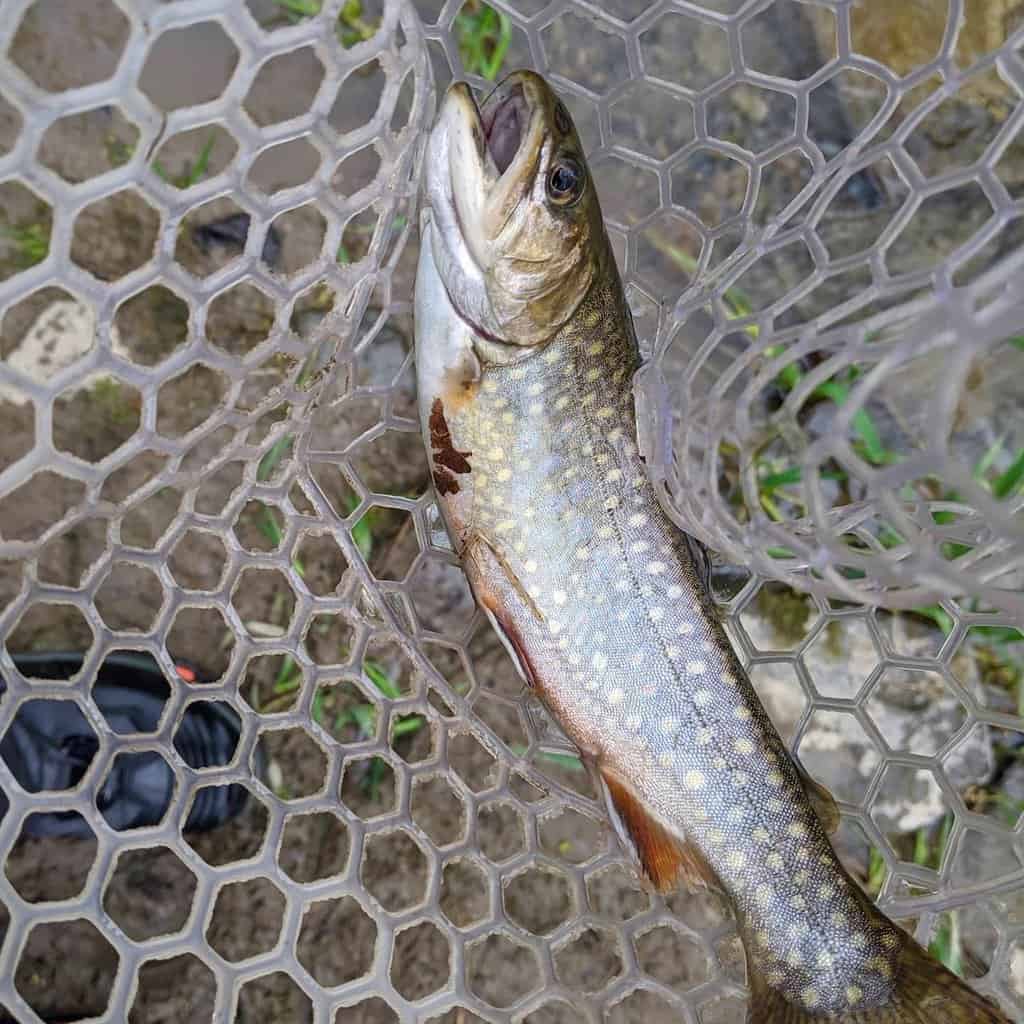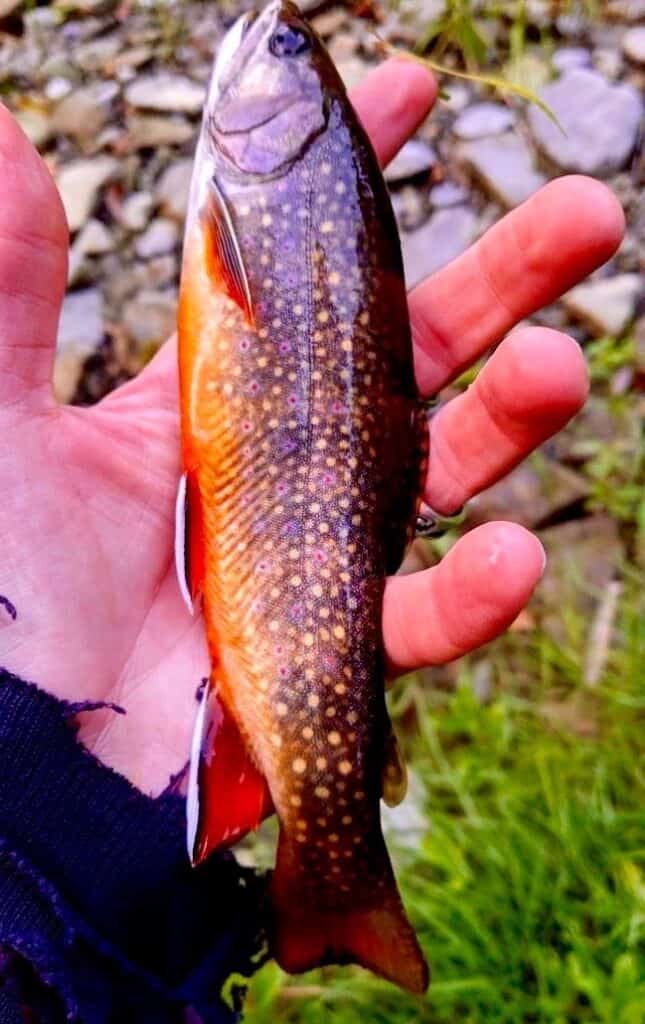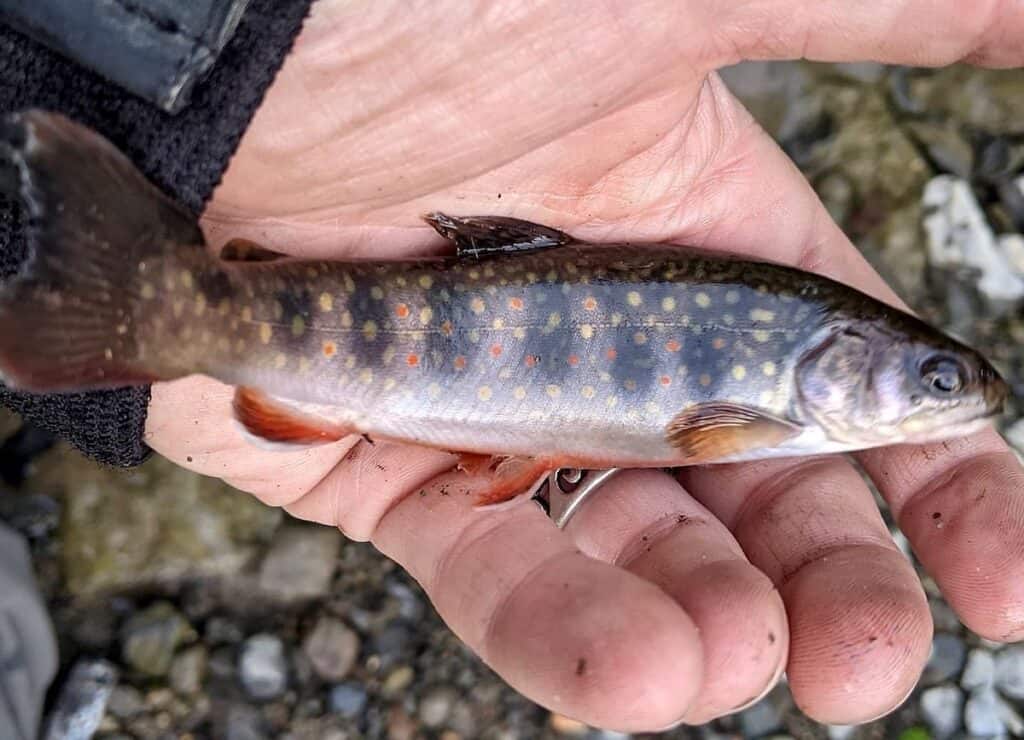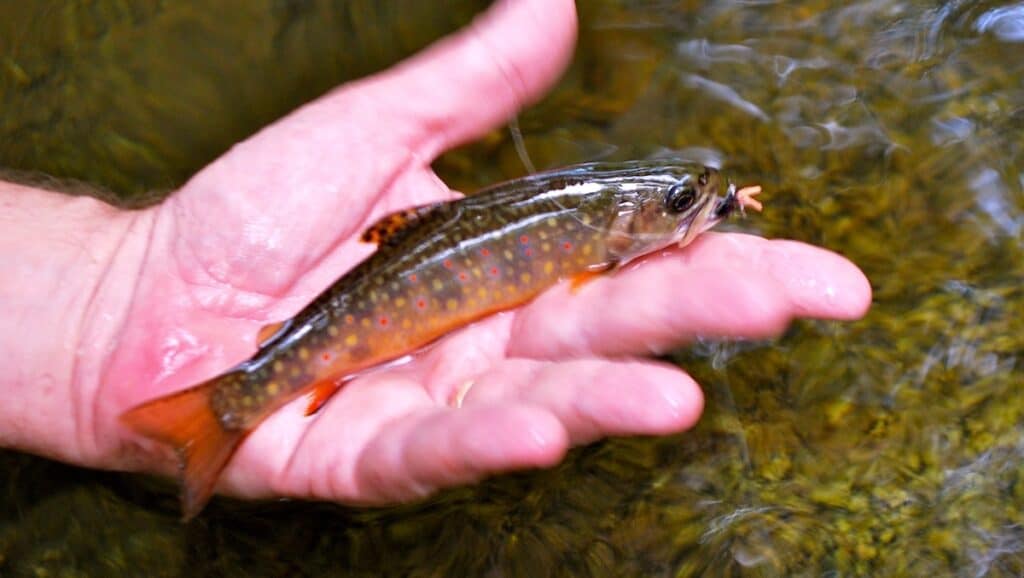Some fish species hold a truly special place in the hearts and minds of anglers. For me, the brook trout is right there near the top.
In this article, I’ll share tactics and tips to help you become a better brook trout angler.
I’m lucky to live at the foothills of the Adirondack Mountains in Upstate New York, where we have several native strains of these trout in lakes, rivers, streams and ponds.
Brookies are magnificently colored fish that live in North America’s most pristine and beautiful places. And they are among my favorite fish to chase, especially in spring and fall.
Where to Catch Brook Trout
Brook trout are native to a wide range of the Eastern United States, from Maine down to the mountains of Georgia and from New York across parts of the upper Midwest.
Native brook trout also thrive in much of Eastern Canada, where they thrive in colder climates and grow to world-record sizes.
Humans have also transplanted brook trout across much of the West and several other continents. In many cases, these fish on the char branch of the trout family tree have established self-sustaining populations.
Just the notion that these fish have been in some of my home waters for millennia is one reason I love this species.
Another endearing element of the brook trout is that because they require such cold, clean water, almost everywhere you’ll find wild brookies is an inherently beautiful place.
It’s important to keep in mind that brook trout have an ideal temperature range of between 45 and 65 degrees, which usually means streams with a steady current or ponds and lakes at higher elevations or with deeper water.
Much of the water in the U.S. simply gets too warm for wild brook trout to survive year-round. Many states also stock brookies.
Salter Brook Trout
Let me take a moment to talk about sea-going brook trout. Several states in New England as well as New York have populations of sea-run, or salter, brook trout. Massachusetts and Maine have the most salter brookies in the U.S.
It is a common misconception that salter brook trout are like other species that live most of their lives in saltwater and move to freshwater only to spawn. Rather, these fish move back and forth between the ocean and freshwater.
Salters spawn and spend the majority of their lives in freshwater along the coastline. They move to saltwater primarily because there’s a greater abundance of forage species and the Atlantic Ocean’s temperatures are more agreeable in the extreme seasons of summer and winter.
Catching and releasing a sea-run brook trout is a truly unique and incredible experience that you should take advantage of if you can, as their numbers have historically been, and still are, in peril.
Fishing with ultralight gear in the same estuaries where I might fish for striped bass was, for me, a surreal experience that I’ll remember forever.
When to Catch Brook Trout
Brook trout behave differently throughout the calendar year, so targeting them effectively depends largely on when you’re fishing.
First off, I recommend carrying a stream thermometer to gauge when targeting brook trout will be worthwhile.
Remember those ideal water temperatures between 45 and 65 degrees, which most often occur during spring and fall. That’s when brook trout fishing peaks in many waters.
Spring Brook Trout Fishing
As the winter ice melts off lakes and streams fill with snowmelt, brook trout will begin to feed actively, and fishing can be excellent. These ideal spring conditions will come at different times, arriving first in the southern range and moving northward.
Spoons, small jigs, dry flies and streamers can all be effective for hungry spring fish.
Summer Brook Trout Fishing
Except for Northern Canada, summer brings slower brook trout fishing as water temperatures warm.
In streams and rivers, look for these fish to move to the deepest, coldest holes on the body of water. Shaded areas can be excellent.
When targeting brook trout in still water, think deep: Spoons that sink quickly and move slowly will be optimal. It will be absolutely crucial to fish at first and last light, when these fish will be feeding in the coldest water of the day.
Tempting a brook trout to eat in the summer in the middle of the day is often a difficult feat. These fish are too acclimated to a colder-water climate to be very active once water temperatures get much warmer than 70 degrees.
Fall Brook Trout Fishing
Fall is, without a doubt, the best time for targeting brook trout.
When these fish go into spawning mode, they become protective of their territory and aggressive toward any perceived threat.
In the fall, spoons and stickbaits fished more actively, even jerked violently, can be incredibly effective.
Expect early fall patterns to be more summer-like, but once water temperatures drop into the right zone, brookies become as active as they will be all year.
Flashy spoons, small stickbaits, or eye-catching streamers can all convince brook trout to attack. Remember that in this season especially, you might be more likely to get aggression strikes rather than hits from a feeding instinct.
Brook trout in bright spawning colors are easier to spot. So not only do I get a bigger kick out of seeing that flash of orange underbelly when a brook trout takes a bait, but I’m more capable of spotting them when they follow or hit.
After spawning, female brook trout will continue to move upstream, creating more redds so that sediment cleared for the new redd washes downstream to protect previously created ones. Males are typically not present on the redds much after the spawn.
In a pond, search out shallow, rocky areas near shore, while in a stream, look for places with a gravel bottom where the current slows. In clearer water, you might see paired brookies suspended in spawning areas.
Winter Brook Trout Fishing
In the winter, these fish will hang in the deeper pools in streams and rivers, but they will remain shallow in frozen lakes.
Brook trout feed less frequently in winter and often look for larger meals when they do feed. At this time of year, they feed more in the middle of the afternoon, when the water is the warmest.
Where it’s legal, live bait is often the most effective way to tempt winter brookies.
See the ice fishing section below for more information on winter fishing in lakes.
How to Catch Brook Trout
Stream Fishing
The key to catching more brook trout on a river or stream is knowing where to find them.
One habitat that brook trout love is submerged wood. Whether it’s fallen trees, branches, or a beaver dam, wood and water make for a great combination.
I’ve had luck around beaver dams, especially, and the pools and eddies they naturally create.
Small spoons, spinners, small stickbaits are all effective methods of enticing moving-water brook trout. Fly casters can do well with both streamers and dry flies.
Another dead giveaway for finding brook trout in moving water is to fish pools or eddies along the bank.
These pockets are favorite brook trout hangouts because they’re often slightly cooler and provide a break from the current for trout waiting to dart out to intercept passing insects or baitfish.
If these areas have woody structures such as fallen trees or overhanging branches, all the more reason to cast into them.
If I see a promising pool, I’ll cast either a gold or silver Phoebe Wobbler at it from as far away as I can and work it from different angles, and at times with different colored Phoebes, as I approach.
The key is remembering that these fish prefer the coldest area in a given body of water for much of the year. The deeper the water, or the more shaded, the better.
Lake Fishing
Still waters, like ponds and lakes, typically produce the largest brook trout in a region. The forage is more abundant and easier to catch, and the fish aren’t competing with a constant current. That combination allows them to pack on the weight at a greater rate.
At first ice-out, the shallowest water will warm into the optimum range for brook trout the soonest.
In the Northeast where I live, from late March to early May, I look for shallow flats between five and 15 feet deep. The season may kick off a bit earlier where you live.
One of the most popular techniques for catching brook trout in still water is a spoon or blade trolled with a worm, or a piece of a worm, behind it. Lake Clear Wabblers, a famous Upstate New York spoon, are enormously effective for boat anglers.
A basic nickel or silver spoon can be very effective if the water is exceedingly clear, such as it typically is after long dry spells in mid-summer.
However, if a great deal of snowmelt or rain is dirtying a pond or lake, switch to more eye-catching colors like chartreuse or another pattern with bright coloration to stand out in murkier water.
Another popular lake lure is a Vibrax spinner. These popular bladed baits are available in sizes ranging from 7/64 of an ounce up to ⅝ of an ounce.
Choose larger, heavier sizes to cover deeper water. But go with the lightest versions if you’re fishing shallower ponds, where you want to maximize the time the lure is fluttering through a shorter water column.
As water temperatures climb into the 60s, look for brook trout to find the deepest water with an adjacent drop-off or shelf nearby.
While brookies may corral baitfish into shallower bays or coves at first and last light, they’ll retreat to deeper sections of the lake as the water warms.
There simply isn’t enough oxygen in the warmer water of shallow flats or bays.
A small bucktail jig with a soft-plastic paddletail or trailer can work well in the summer because it will get down quickly and work the bottom effectively.
In the fall, brook trout in lakes will begin their spawning behavior. If a river or stream flows into the lake or pond, look for these fish to congregate near the mouth and move up them as they prepare to spawn.
If no streams flow in, shallower areas with rocky bottom are ideal for a still-water redd. Pay attention to local regulations, as some states do close fishing for brook trout during the spawn.
Location will be crucial in your fall fishing, as these fish will hold tightly on those redds for much of the spawning season.
I recommend a run-and-gun approach if you are not having success in a given location. Also, use polarized lenses and a keen eye to keep watch for flashes of orange that will indicate brookies on a redd.
Brook Trout Fly Fishing
Catching a brook trout on dry fly could easily be described as the quintessential stream experience.
Brook trout are one of the most revered and beloved of the trout species, and enticing them to take a dry fly is one of the most challenging and nuanced ways of targeting them.
When the water temperatures on streams and rivers begin climbing through the 40s and 50s, you’ll see different insects show up on the scene that are favorites on the brook trout menu.
The timing of the water temperature reaching this range and the corresponding hatches will vary by region.
In the spring, black, elkhair caddis, stimulators and mayfly patterns can all be effective.
A Royal Coachman or a March brown are both good options for March and April in the Mid-Atlantic, and April and May in much of the Northeast and West.
Before water temperatures climb in the summer, a dropper-and-a-dry technique, whereby a nymph is fished below a dry fly, can be extremely effective.
When water temperatures get up into the ideal range for brook trout, you’ll see more fish rising to dries, and you can target them more effectively on top.
Take note of which fly the fish are predominantly hitting, and when you’re getting most of your fish on the dry, you can clip off the dropper.
Stimulator patterns and terrestrials, like ant patterns, can be great flies in the spring and summer as well.
As fish push deeper in the summer heat, switch back to nymphs and streamers like a Muddler Minnow or a Wooly Bugger.
The tactic known as Euro-nymphing has become increasingly popular in recent years and can be an effective means to catch brook trout, especially in the late spring and summer when they push deep and become less active.
Basically, instead of fishing a nymph underneath a float or with split-shot, with Euro nymphing, you use a colored leader that allows you to keep an eye on the leader and gauge the depth of your fly.
With this technique, you have better contact with and feel for your nymph, which has a more natural presentation without a float or weights. This tactic can be deadly in the summer months, especially.
Once the fall comes around, streamers become a favorite fly for brook trout anglers. With streamers like a Wooly Bugger, you can cover more water and entice an aggression strike more effectively.
The Blacknose Dace, Baby Brook Trout, Grey Ghost and Hornberg are extremely popular autumn patterns for moving-water brook trout.
In lakes and ponds, your best chances for brookies on the fly will be in the spring, when they are shallow right after ice-out, and in the fall, when they are moving up onto patches of gravel in preparation for the spawn.
Brook Trout Ice Fishing
Some of the biggest brook trout are taken through the ice, as these coldwater fish are still feeding, especially in the first part of the winter.
Target the shallowest areas in a lake or pond once there is safe ice, and especially look for fallen trees, stumps, iced-over beaver dams or brushpiles.
The fish will be especially shallow at first light as they look for small baitfish and insects in 3 and 10 feet of water. Brook trout typically push deeper by afternoon, so adjust your hole locations accordingly.
Although many ice jigs and spoons can be effective for winter brook trout, anglers often catch the biggest fish on live bait (where allowed).
However, it is important to keep your bait small. A long worm or full-sized shiner will often get a brook trout to attack, but for solid hook-ups, opt for a bait these fish can get into their mouths.
On bodies of water where bait is not permitted, small spoons in chartreuse, orange, or solid silver and gold can be extremely effective; just keep them moving.
Don’t be afraid to bounce around, drilling new holes if you’re not finding fish right away.
A combination of bait and artificials is yet another option. Some anglers will tie to a spoon (like a small Mooselook Wobbler) and have a leader running off the spoon with a small piece of a worm on the end.
The lure acts as an attractant, and the bait seals the deal.
No matter the season or the geographic location where you’re targeting brook trout, they are bound to become one of your favorite species if they aren’t already.
Catch More Brook Trout
Be sure to read our Complete Guide to Brook Trout Lures, Flies and Baits.
Also, check our our basic guide to trout fishing for more tips and techniques for all popular trout species.




